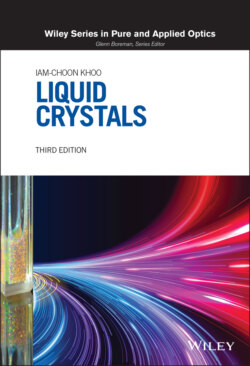Читать книгу Liquid Crystals - Iam-Choon Khoo - Страница 23
1.4.3. Polymer‐dispersed and Polymer‐stabilized Liquid Crystals
ОглавлениеJust as the presence of dye molecules modifies the absorption characteristics of liquid crystals, the inclusion of liquid crystals in the material of different refractive indexes modifies the light scattering properties of the resulting “mixed” system. A good example is polymer‐dispersed liquid crystals (PDLC) formed by introducing liquid crystals as micron‐ or sub‐micron‐sized droplets into a polymer matrix. The optical indices of these randomly oriented liquid crystal droplets, in the absence of an external alignment field, depend on the liquid crystal–polymer interaction at the boundary and therefore assume a random distribution (cf. Figure 1.18a). This causes large scattering [18]. Upon the application of an external field, the droplets will be aligned (Figure 1.18b), and the system will become clear as the refractive index of the liquid crystal droplets matches the isotropic polymer backgrounds.
Figure 1.17. Alignment of a dichroic dye‐doped nematic liquid crystal: (a) before application of switching electric field; (b) switching field on.
Figure 1.18. Schematic depiction of a polymer‐dispersed liquid crystal material: (a) in the absence of an external alignment field, highly scattered state; (b) when an external alignment field is on, transparent state.
There are now many techniques for preparing such polymer‐liquid crystalline composite, including the phase separation and the encapsulation methods [2, 19] for PDLC, and optical holographic interference methods [20–22] for making PDLC photonic crystals and grating [23, 24] have also demonstrated 1‐D polymer/liquid crystal layered structures that exhibit high diffraction efficiency as well as laser emission capabilities.
Another type of polymer‐liquid crystal “composite” is formed by mixing liquid crystal with monomer and subject the mixture to UV light. The rigid polymer network that results from the curing of the monomer follows the liquid crystal order and is able to extend the temperature range of the mesophase. This procedure has been employed to extend the temperature range of BPLCs from a few degrees to over 60° [25], for example.
